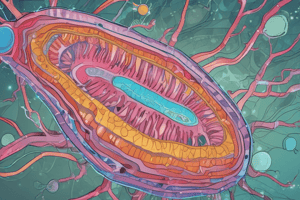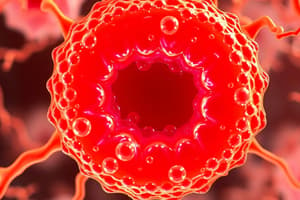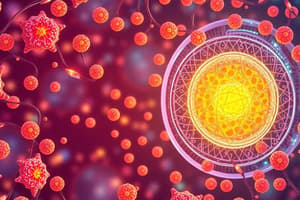Podcast
Questions and Answers
How do organelles import proteins?
How do organelles import proteins?
- By passive diffusion only
- Through a single universal method
- By one of three mechanisms (correct)
- By facilitated transport alone
The synthesis of all nuclear-encoded proteins starts in the nucleus.
The synthesis of all nuclear-encoded proteins starts in the nucleus.
False (B)
What is the role of signal sequences in protein sorting?
What is the role of signal sequences in protein sorting?
Signal sequences direct proteins to the correct organelle.
Proteins that lack a signal sequence are usually ______.
Proteins that lack a signal sequence are usually ______.
Match each protein signal feature to its description:
Match each protein signal feature to its description:
What is the main function of the import receptor (R) in peroxisome import?
What is the main function of the import receptor (R) in peroxisome import?
The SKL signal sequence on the cargo is cleaved off after import into the peroxisome.
The SKL signal sequence on the cargo is cleaved off after import into the peroxisome.
Where is catalase likely to be located in cells without peroxisomes?
Where is catalase likely to be located in cells without peroxisomes?
The import of soluble proteins into peroxisomes requires ____ hydrolysis by a complex in the peroxisome membrane.
The import of soluble proteins into peroxisomes requires ____ hydrolysis by a complex in the peroxisome membrane.
Match the terms with their correct descriptions regarding protein import:
Match the terms with their correct descriptions regarding protein import:
What type of transport do nuclear import receptors utilize to bind to cargo?
What type of transport do nuclear import receptors utilize to bind to cargo?
Nuclear pores allow only small proteins to pass freely into the nucleus.
Nuclear pores allow only small proteins to pass freely into the nucleus.
What is the purpose of a nuclear localization signal (NLS)?
What is the purpose of a nuclear localization signal (NLS)?
The compartmentalization of Ran-GDP and Ran-GTP provides __________ in nuclear transport.
The compartmentalization of Ran-GDP and Ran-GTP provides __________ in nuclear transport.
Match the following terms with their descriptions:
Match the following terms with their descriptions:
Which of the following correctly describes the state of proteins when entering the nucleus?
Which of the following correctly describes the state of proteins when entering the nucleus?
All proteins can freely diffuse through nuclear pores without any assistance.
All proteins can freely diffuse through nuclear pores without any assistance.
What role does GTP hydrolysis play in nuclear transport?
What role does GTP hydrolysis play in nuclear transport?
What is the function of TOM in the mitochondrial import process?
What is the function of TOM in the mitochondrial import process?
Active import of proteins into the mitochondria does not require energy.
Active import of proteins into the mitochondria does not require energy.
What is produced when peroxisomes carry out oxidation reactions?
What is produced when peroxisomes carry out oxidation reactions?
The TIM complex is responsible for translocation across the _______ membrane.
The TIM complex is responsible for translocation across the _______ membrane.
What would likely happen if you change charged amino acids in a mitochondrial signal sequence to acidic amino acids?
What would likely happen if you change charged amino acids in a mitochondrial signal sequence to acidic amino acids?
Peroxisomes bud off from the Golgi apparatus.
Peroxisomes bud off from the Golgi apparatus.
Match the following mitochondrial translocation components with their functions:
Match the following mitochondrial translocation components with their functions:
What is the primary role of catalase in peroxisomes?
What is the primary role of catalase in peroxisomes?
Which alteration would lead to decreased nuclear localization of NFᴋB after interleukin stimulation?
Which alteration would lead to decreased nuclear localization of NFᴋB after interleukin stimulation?
The nuclear localization signal (NLS) of NFᴋB is blocked by IᴋB under infection conditions.
The nuclear localization signal (NLS) of NFᴋB is blocked by IᴋB under infection conditions.
What must an endosymbiont be able to do inside its host?
What must an endosymbiont be able to do inside its host?
The signal sequence for mitochondrial import is usually found at the _______ of a polypeptide.
The signal sequence for mitochondrial import is usually found at the _______ of a polypeptide.
Match the following steps of endosymbiont evolution with their descriptions:
Match the following steps of endosymbiont evolution with their descriptions:
What kind of residues are involved in the signal sequence for mitochondrial import?
What kind of residues are involved in the signal sequence for mitochondrial import?
Mitochondrial precursor proteins are folded during import.
Mitochondrial precursor proteins are folded during import.
The process of protein translocation into mitochondria generally requires a ______ and a translocation channel.
The process of protein translocation into mitochondria generally requires a ______ and a translocation channel.
Flashcards
Protein sorting in cells
Protein sorting in cells
The process of delivering proteins to the correct organelles within a eukaryotic cell.
Signal sequences
Signal sequences
Short amino acid sequences within a protein that act as a 'postal code' directing the protein to its target organelle.
Protein import mechanisms
Protein import mechanisms
Different ways proteins are transported to their target organelles, including unidirectional and bidirectional transport.
Signal sequence features
Signal sequence features
Signup and view all the flashcards
Protein with no signal
Protein with no signal
Signup and view all the flashcards
Nuclear Pore Function
Nuclear Pore Function
Signup and view all the flashcards
Nuclear Localization Signal (NLS)
Nuclear Localization Signal (NLS)
Signup and view all the flashcards
Nuclear Import
Nuclear Import
Signup and view all the flashcards
Nuclear Import Receptor
Nuclear Import Receptor
Signup and view all the flashcards
Ran-GTP
Ran-GTP
Signup and view all the flashcards
Size Exclusion Chromatography
Size Exclusion Chromatography
Signup and view all the flashcards
Nuclear Export
Nuclear Export
Signup and view all the flashcards
Gated Transport
Gated Transport
Signup and view all the flashcards
NFκB and Infection
NFκB and Infection
Signup and view all the flashcards
NFκB Nuclear Localization
NFκB Nuclear Localization
Signup and view all the flashcards
What Decreases NFκB Nuclear Localization?
What Decreases NFκB Nuclear Localization?
Signup and view all the flashcards
Signal Sequence for Mitochondrial Import
Signal Sequence for Mitochondrial Import
Signup and view all the flashcards
Mitochondrial Signal Sequence Features
Mitochondrial Signal Sequence Features
Signup and view all the flashcards
Unfolded Import into Mitochondria
Unfolded Import into Mitochondria
Signup and view all the flashcards
Endosymbiotic Theory
Endosymbiotic Theory
Signup and view all the flashcards
Endosymbiont to Organelle: Steps
Endosymbiont to Organelle: Steps
Signup and view all the flashcards
Peroxisome import: Folded proteins?
Peroxisome import: Folded proteins?
Signup and view all the flashcards
Peroxisome import: What resembles nuclear import?
Peroxisome import: What resembles nuclear import?
Signup and view all the flashcards
Peroxisome import: What resembles mitochondrial import?
Peroxisome import: What resembles mitochondrial import?
Signup and view all the flashcards
Catalase in peroxisome-deficient cells
Catalase in peroxisome-deficient cells
Signup and view all the flashcards
Catalase: Why dots in normal cells?
Catalase: Why dots in normal cells?
Signup and view all the flashcards
Mitochondrial Import: TOM & TIM
Mitochondrial Import: TOM & TIM
Signup and view all the flashcards
Signal Sequence: Mitochondrial Import
Signal Sequence: Mitochondrial Import
Signup and view all the flashcards
Mitochondrial Import: Energy Required
Mitochondrial Import: Energy Required
Signup and view all the flashcards
Mitochondrial Import: Hydrophobic Signal Sequence
Mitochondrial Import: Hydrophobic Signal Sequence
Signup and view all the flashcards
Mitochondrial Import: Signal Sequence Function
Mitochondrial Import: Signal Sequence Function
Signup and view all the flashcards
Peroxisomes: Function & Origin
Peroxisomes: Function & Origin
Signup and view all the flashcards
Peroxisomes: Biochemical Activities
Peroxisomes: Biochemical Activities
Signup and view all the flashcards
Peroxisomes: Electron-Dense Cores
Peroxisomes: Electron-Dense Cores
Signup and view all the flashcards
Study Notes
Protein Sorting I: Nucleus, Mitochondria, and Peroxisomes
- Eukaryotic cells contain numerous membrane-bound compartments.
- These include the nucleus, mitochondria, chloroplasts (plants), endoplasmic reticulum (ER), Golgi apparatus, endosomes, lysosomes, and vesicles.
- Peroxisomes are also important membrane-bound organelles.
- Organelles occupy roughly half a cell's volume.
- For example, mitochondria represent about 22% of the total cell volume in a typical liver cell (hepatocyte).
- This means hepatocytes have approximately 1,700 mitochondria per cell in a typical case.
Protein Delivery Mechanisms
- Proteins are delivered to the correct compartments within a eukaryotic cell through three main mechanisms.
- The first is transport through nuclear pores.
- The second is transport across membranes.
- The third method involves transport via vesicles.
Protein Import Into Organelles: Signal Sequences
- The synthesis of nuclear-encoded proteins starts in the cytoplasm.
- Proteins have signal sequences that act as postal codes guiding them to their designated organelles.
- Signal sequences are amino acid sequences at the protein's N-terminus or amino end.
- Signal sequences direct proteins to the correct location.
Nuclear Import
- Nuclear pores are the sole pathways for molecules to enter and leave the nucleus.
- Proteins cross nuclear pores in their fully folded states.
- Small proteins (<40 kDa) enter via diffusion, while larger proteins (>40kDa), require active transport.
- Nuclear import receptors bind cargo proteins that have nuclear localization signals (NLSs).
- NLS are encoded parts of proteins.
- These receptors recognize different NLS sequences, recognizing a wide variety of NLS.
- GTP hydrolysis is needed to drive nuclear transport and release cargo.
Nuclear Export
- Nuclear export is similar to import but in reverse.
- It involves the nuclear export receptor's recognition and binding to export signals (NESs) on proteins destined for the cytoplasm.
- Proteins with NESs bind to nuclear export receptors, and are released to the cytosol with the help of Ran-GTP.
Protein Import into Mitochondria
- Precursor proteins are unfolded during import into mitochondria.
- The import process requires energy.
- The signal sequence at the N-terminus of the precursor protein is recognized, followed by translocations across the mitochondrial outer and inner membranes.
- ATP hydrolysis aids the translocation, pushing the protein into the matrix space.
- TIM and TOM complexes participate in this protein import process.
Protein Import into Peroxisomes
- Similar to mitochondrial import, proteins are imported into peroxisomes in their folded state.
- Peroxisomal import involves an import receptor that recognizes C-terminal signal sequences (SKL).
- The receptor shuttles proteins into the peroxisome, but the signal sequence isn't cleaved off.
- The receptor gets recycled to the cytoplasm.
Studying That Suits You
Use AI to generate personalized quizzes and flashcards to suit your learning preferences.



